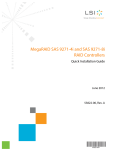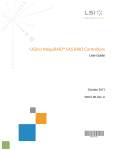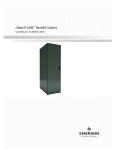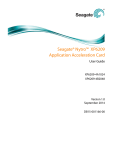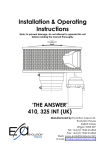Download LSI Nytro MegaRAID 8110-4i
Transcript
LSI® Nytro™ MegaRAID® Application Acceleration Card User Guide Version 1.2, August 2012 DB15-000967-01 LSI Nytro MegaRAID Application Acceleration Card User Guide August 2012 Revision History Version and Date Description of Changes Version 1.2, August 2012 Final release of this document. Version 1.1, August 2012 Updated the artwork. Version 1.0, June 2012 Initial release of this document. LSI and the LSI & Design logo, Nytro, MegaRAID, and Fusion-MPT are trademarks or registered trademarks of LSI Corporation or its subsidiaries. All other brand and product names may be trademarks of their respective companies. Windows is a registered trademark of Microsoft Corporation. Linux is the registered trademark of Linus Torvalds in the U.S. and other countries. Solaris is a trademark of Oracle America, Inc. Red Hat and Enterprise Linux are registered trademarks of Red Hat, Inc. SUSE is a registered trademark of Novell, Inc. SPARC is a registered trademark of SPARC International, Inc. LSI Corporation reserves the right to make changes to the product(s) or information disclosed herein at any time without notice. LSI Corporation does not assume any responsibility or liability arising out of the application or use of any product or service described herein, except as expressly agreed to in writing by LSI Corporation; nor does the purchase, lease, or use of a product or service from LSI Corporation convey a license under any patent rights, copyrights, trademark rights, or any other of the intellectual property rights of LSI Corporation or of third parties. LSI products are not intended for use in life-support appliances, devices, or systems. Use of any LSI product in such applications without written consent of the appropriate LSI officer is prohibited. Corporate Headquarters Milpitas, CA 800-372-2447 Document Number: DB15-000967-01 Copyright © 2012 LSI Corporation All Rights Reserved Email [email protected] Website www.lsi.com LSI Nytro MegaRAID Application Acceleration Card User Guide August 2012 Table of Contents Table of Contents Chapter 1: Overview of the LSI Nytro MegaRAID Card . . . . . . . . . . . . . . . . . . . . . . . . . . . . . . . . . . . . . . . . . . . . . . . . . . . . . . . . . . . . . . . . . . . . . . . . . . . . . . . . . . . . . .4 1.1 Overview . . . . . . . . . . . . . . . . . . . . . . . . . . . . . . . . . . . . . . . . . . . . . . . . . . . . . . . . . . . . . . . . . . . . . . . . . . . . . . . . . . . . . . . . . . . . . . . . . . . . . . . . . . . . . . . . . . . . . . .4 1.1.1 Key Features and Benefits of the Nytro MegaRAID Card . . . . . . . . . . . . . . . . . . . . . . . . . . . . . . . . . . . . . . . . . . . . . . . . . . . . . . . . . . . . . . .5 1.1.2 Configuration Scenarios . . . . . . . . . . . . . . . . . . . . . . . . . . . . . . . . . . . . . . . . . . . . . . . . . . . . . . . . . . . . . . . . . . . . . . . . . . . . . . . . . . . . . . . . . . . . .6 1.2 Support . . . . . . . . . . . . . . . . . . . . . . . . . . . . . . . . . . . . . . . . . . . . . . . . . . . . . . . . . . . . . . . . . . . . . . . . . . . . . . . . . . . . . . . . . . . . . . . . . . . . . . . . . . . . . . . . . . . . . . . .7 Chapter 2: Nytro MegaRAID SAS Hardware Installation . . . . . . . . . . . . . . . . . . . . . . . . . . . . . . . . . . . . . . . . . . . . . . . . . . . . . . . . . . . . . . . . . . . . . . . . . . . . . . . . . . . .8 2.1 Requirements . . . . . . . . . . . . . . . . . . . . . . . . . . . . . . . . . . . . . . . . . . . . . . . . . . . . . . . . . . . . . . . . . . . . . . . . . . . . . . . . . . . . . . . . . . . . . . . . . . . . . . . . . . . . . . . . . . .8 2.2 Installation and Configuration Overview . . . . . . . . . . . . . . . . . . . . . . . . . . . . . . . . . . . . . . . . . . . . . . . . . . . . . . . . . . . . . . . . . . . . . . . . . . . . . . . . . . . . . . . . .8 2.3 Hardware and Software Installation Overview . . . . . . . . . . . . . . . . . . . . . . . . . . . . . . . . . . . . . . . . . . . . . . . . . . . . . . . . . . . . . . . . . . . . . . . . . . . . . . . . . . . .9 2.4 Quick Installation of the Nytro MegaRAID Card . . . . . . . . . . . . . . . . . . . . . . . . . . . . . . . . . . . . . . . . . . . . . . . . . . . . . . . . . . . . . . . . . . . . . . . . . . . . . . . . . .10 2.5 Detailed Installation of the Nytro MegaRAID Card . . . . . . . . . . . . . . . . . . . . . . . . . . . . . . . . . . . . . . . . . . . . . . . . . . . . . . . . . . . . . . . . . . . . . . . . . . . . . . .11 2.6 RAID Cache Protection Kit (Optional) . . . . . . . . . . . . . . . . . . . . . . . . . . . . . . . . . . . . . . . . . . . . . . . . . . . . . . . . . . . . . . . . . . . . . . . . . . . . . . . . . . . . . . . . . . .12 2.7 SAS Device Cables and Connectors . . . . . . . . . . . . . . . . . . . . . . . . . . . . . . . . . . . . . . . . . . . . . . . . . . . . . . . . . . . . . . . . . . . . . . . . . . . . . . . . . . . . . . . . . . . . .13 2.8 After Installing the Nytro MegaRAID Card . . . . . . . . . . . . . . . . . . . . . . . . . . . . . . . . . . . . . . . . . . . . . . . . . . . . . . . . . . . . . . . . . . . . . . . . . . . . . . . . . . . . . . .13 Chapter 3: Nytro MegaRAID Card Characteristics . . . . . . . . . . . . . . . . . . . . . . . . . . . . . . . . . . . . . . . . . . . . . . . . . . . . . . . . . . . . . . . . . . . . . . . . . . . . . . . . . . . . . . . . . .14 3.1 Flash Memory Capacity . . . . . . . . . . . . . . . . . . . . . . . . . . . . . . . . . . . . . . . . . . . . . . . . . . . . . . . . . . . . . . . . . . . . . . . . . . . . . . . . . . . . . . . . . . . . . . . . . . . . . . . .14 3.2 LEDs . . . . . . . . . . . . . . . . . . . . . . . . . . . . . . . . . . . . . . . . . . . . . . . . . . . . . . . . . . . . . . . . . . . . . . . . . . . . . . . . . . . . . . . . . . . . . . . . . . . . . . . . . . . . . . . . . . . . . . . . . . .14 3.2.1 Dirty Cache LED Header (J1) . . . . . . . . . . . . . . . . . . . . . . . . . . . . . . . . . . . . . . . . . . . . . . . . . . . . . . . . . . . . . . . . . . . . . . . . . . . . . . . . . . . . . . . . .14 3.2.2 Activity LED Header (J4) . . . . . . . . . . . . . . . . . . . . . . . . . . . . . . . . . . . . . . . . . . . . . . . . . . . . . . . . . . . . . . . . . . . . . . . . . . . . . . . . . . . . . . . . . . . . .15 3.2.3 Heartbeat LED . . . . . . . . . . . . . . . . . . . . . . . . . . . . . . . . . . . . . . . . . . . . . . . . . . . . . . . . . . . . . . . . . . . . . . . . . . . . . . . . . . . . . . . . . . . . . . . . . . . . . .15 3.2.4 Life Status LED . . . . . . . . . . . . . . . . . . . . . . . . . . . . . . . . . . . . . . . . . . . . . . . . . . . . . . . . . . . . . . . . . . . . . . . . . . . . . . . . . . . . . . . . . . . . . . . . . . . . . .15 3.2.5 LEDs on the Backside of the board . . . . . . . . . . . . . . . . . . . . . . . . . . . . . . . . . . . . . . . . . . . . . . . . . . . . . . . . . . . . . . . . . . . . . . . . . . . . . . . . . .15 3.3 Connectors . . . . . . . . . . . . . . . . . . . . . . . . . . . . . . . . . . . . . . . . . . . . . . . . . . . . . . . . . . . . . . . . . . . . . . . . . . . . . . . . . . . . . . . . . . . . . . . . . . . . . . . . . . . . . . . . . . . .15 3.3.1 RAID Cache Protection Module Connector (J3) . . . . . . . . . . . . . . . . . . . . . . . . . . . . . . . . . . . . . . . . . . . . . . . . . . . . . . . . . . . . . . . . . . . . . . .15 3.3.2 UART Connector (J5) . . . . . . . . . . . . . . . . . . . . . . . . . . . . . . . . . . . . . . . . . . . . . . . . . . . . . . . . . . . . . . . . . . . . . . . . . . . . . . . . . . . . . . . . . . . . . . . .16 3.3.3 Modular RAID Key Header (J6) . . . . . . . . . . . . . . . . . . . . . . . . . . . . . . . . . . . . . . . . . . . . . . . . . . . . . . . . . . . . . . . . . . . . . . . . . . . . . . . . . . . . . . .16 3.3.4 SAS/SATA Connector (J7) . . . . . . . . . . . . . . . . . . . . . . . . . . . . . . . . . . . . . . . . . . . . . . . . . . . . . . . . . . . . . . . . . . . . . . . . . . . . . . . . . . . . . . . . . . .16 3.3.5 Flash Module Connectors(J8 and J9) . . . . . . . . . . . . . . . . . . . . . . . . . . . . . . . . . . . . . . . . . . . . . . . . . . . . . . . . . . . . . . . . . . . . . . . . . . . . . . . . .16 3.3.6 LSI Test Header (J10) . . . . . . . . . . . . . . . . . . . . . . . . . . . . . . . . . . . . . . . . . . . . . . . . . . . . . . . . . . . . . . . . . . . . . . . . . . . . . . . . . . . . . . . . . . . . . . . .16 3.3.7 PCIe Connector (J11) . . . . . . . . . . . . . . . . . . . . . . . . . . . . . . . . . . . . . . . . . . . . . . . . . . . . . . . . . . . . . . . . . . . . . . . . . . . . . . . . . . . . . . . . . . . . . . . .16 3.3.8 Physical Characteristics . . . . . . . . . . . . . . . . . . . . . . . . . . . . . . . . . . . . . . . . . . . . . . . . . . . . . . . . . . . . . . . . . . . . . . . . . . . . . . . . . . . . . . . . . . . . .16 3.4 Environmental Specifications . . . . . . . . . . . . . . . . . . . . . . . . . . . . . . . . . . . . . . . . . . . . . . . . . . . . . . . . . . . . . . . . . . . . . . . . . . . . . . . . . . . . . . . . . . . . . . . . . . .18 3.4.1 Power Requirements . . . . . . . . . . . . . . . . . . . . . . . . . . . . . . . . . . . . . . . . . . . . . . . . . . . . . . . . . . . . . . . . . . . . . . . . . . . . . . . . . . . . . . . . . . . . . . .18 3.4.2 Thermal and Atmospheric Limits . . . . . . . . . . . . . . . . . . . . . . . . . . . . . . . . . . . . . . . . . . . . . . . . . . . . . . . . . . . . . . . . . . . . . . . . . . . . . . . . . . . .18 3.5 Nytro MegaRAID Card Certifications and Safety Characteristics . . . . . . . . . . . . . . . . . . . . . . . . . . . . . . . . . . . . . . . . . . . . . . . . . . . . . . . . . . . . . . . . . .18 Glossary . . . . . . . . . . . . . . . . . . . . . . . . . . . . . . . . . . . . . . . . . . . . . . . . . . . . . . . . . . . . . . . . . . . . . . . . . . . . . . . . . . . . . . . . . . . . . . . . . . . . . . . . . . . . . . . . . . . . . . . . . . . . . . . . . . .20 LSI Corporation -3- LSI Nytro MegaRAID Application Acceleration Card User Guide August 2012 Overview of the LSI Nytro MegaRAID Card Overview Chapter 1: Overview of the LSI Nytro MegaRAID Card 1.1 Overview This document is the primary reference and user’s guide for the LSI® Nytro™ MegaRAID® Application Acceleration Card based on the LSI 6Gb/s SAS/SATA RAID On-a-Chip device. This document contains complete installation instructions for the Nytro MegaRAID card and includes the cards specifications. The LSI Nytro MegaRAID Application Acceleration Card is a combination of LSI proven MegaRAID controller coupled with built-in Flash modules to be used as data cache devices with the help of LSI CacheCade software. The Nytro MegaRAID card for direct-attached storage (DAS) is designed to accelerate applications with RAID performance from DAS combined with intelligent caching using Nytro Flash modules. The Nytro MegaRAID card increases the storage performance up to 30x, but retains the current investment in DAS. Using intelligent caching algorithms to help identify application hot data, the frequently accessed data is stored and accessed from Flash enabling the lowest possible latency. The following figure illustrates the flow of data on the Nytro MegaRAID card. Figure 1 Data Flow on a Nytro MegaRAID Card ATTENTION Convention of usage of important terms: Nytro Cache: This term refers to the Nytro Flash module is used for user data cache, called Nytro Cache. SSD: This term refers to external SSDs. LSI offers a family of Nytro MegaRAID cards that provides enterprise proven performance acceleration and data protection for direct attach storage (DAS). The differences between the Nytro MegaRAID cards are the amount of Flash memory as shown in the following table. Table 1 Nytro MegaRAID Board Sizes Nytro MegaRAID Card Flash Capacity Nytro MegaRAID8100-4i 128 GB Nytro MegaRAID8110-4i 256 GB Nytro MegaRAID8120-4i 1 TB LSI Corporation -4- LSI Nytro MegaRAID Application Acceleration Card User Guide August 2012 Overview of the LSI Nytro MegaRAID Card Overview These cards address the growing demand for increased data throughput in database applications, cloud computing, and data centers. These cards provide: A four-lane mini-SAS connector for internal disk connection to 6.0 Gb/s SAS/SATA hard disk drives or internal drive bay connection An eight-lane, PCI Express 2.0 host interface Nytro Flash module - up to 1TB capacity (2 Nytro Flash modules) Flash volumes for caching — Nytro Flash modules automatically configured to single Nytro cache drive by default — Existing and new Nytro cache drives automatically assigned for caching Optional SuperCap connection to protect DRAM content in the event of power failure Caching lightens the HDD load so that HDD RAID rebuilds complete faster and removes traditional HDD head wear from accessing small block requests typical in database environments The Nytro MegaRAID card provides accelerated performance and improved manageability to MegaRAID with its two embedded Nytro Flash modules. The Nytro MegaRAID card uses Nytro Flash memory in front of the connected hard disk drive (HDD) volumes to create high-capacity and high-performance acceleration cache pools. The Nytro MegaRAID card is based on the LSISAS2208 RAID On-a-Chip (ROC). This device is compliant with the FusionMPT™ architecture and provides a PCI Express x8 interface. The Nytro MegaRAID card provides enterprise class data protection and transparent performance acceleration to direct-attached SCSI storage volumes. The card provides reliability, high performance, and fault-tolerant drive subsystem management. Performance acceleration is powered by intelligent caching using the onboard Nytro Flash module. NOTE You need to carefully assess any decision to mix SAS drives and SATA drives within the same virtual drive (VD). Although you can mix drives, this practice is strongly discouraged because the drives have different performance and reliability characteristics. 1.1.1 Key Features and Benefits of the Nytro MegaRAID Card Automatic self-starting and self-configuring Supports Read and Write caching Transparent to applications, file systems, OSs, and device drivers Provides an economical solution for accelerating applications — by storing frequently accessed data on low latency Nytro Flash modules while existing SAS or SATA connected hard drives to achieve a balance of performance and cost savings Uses Nytro Flash module reducing compatibility issues Specialized server off load processors include the LSISAS2208 dual core RAID-on-Chip process and two LSI SandForce® SF-2582 Nytro Flash modules MD2 Low profile (6.6" X 2.536") x8 PCI Express 2.0 host interface RAID level support for Nytro Flash modules as RAID 0 or RAID 1 — RAID1 is enabled when the user enables the write-back mode of the cache — On initial power up, the card auto configures as Nytro Cache Drive Group 0, RAID 1, Write Back configuration RAID level support for hard disk drives — RAID levels 0, 1, 5, and 6 — RAID spans 10, 50, and 60 Internal drive bay support JBOD mode support LSI Corporation -5- LSI Nytro MegaRAID Application Acceleration Card User Guide August 2012 Nytro Flash module helps protect cache in the event of power fail — no battery required SuperCap kit (option) to protect DRAM content in the event of power failure Faster rebuilds will occur due to servicing most storage requests from Nytro Flash module Compatible with existing MSM management interfaces Zero administrative overhead Configuration Scenarios You can use the Nytro MegaRAID cards in the following scenarios: Low-end, internal SATA configuration: In this configuration, use the RAID card as a high-end SATA, SATA II, or SATA III compatible card that directlyconnects up to four drives or an internal expander. This configuration is mostly for low-end or entry servers. Enclosure management is provided through an out-of-band I2C bus. Midrange internal SAS configuration: This configuration is like an internal SATA configuration, but with high-end SAS drives. This configuration is more suitable for low-range to midrange servers. The following figure illustrates a direct-connect configuration. The Inter-IC (I2C) interface communicates with peripherals. The external memory bus provides a 32-bit memory bus, parity checking, and chip select signals for pipelined synchronous burst static random access memory (PSBRAM), non-volatile static random access memory (NVSRAM), and Flash ROM. The card can connect to an internal drive bay that uses an expander. Figure 2 Example of an Nytro MegaRAID Card with Direct-Connect Application 32-Bit Memory Address/Data Bus Flash ROM/ PSBRAM/ NVSRAM SAS/SATA Device SAS/SATA Device I2C Interface SAS PCI Express RAID Controller SAS/SATA Device I2C Nytro Flash Module SAS/SATA Device Nytro Flash Module 8 PCI Express Interface Internal Drive Bay with LSI SAS Expander 32-Bit Memory Address/Data Bus 4 Flash ROM/ PSBRAM/ NVSRAM I2C Interface SAS PCI Express RAID Controller I2 C Nytro Flash Module Nytro Flash Module SAS/SATA Devices SAS/SATA Devices SAS/SATA Devices SAS/SATA Devices SAS/SATA Devices SAS/SATA Devices 1.1.2 Overview of the LSI Nytro MegaRAID Card Overview 8 PCI Express Interface LSI Corporation -6- LSI Nytro MegaRAID Application Acceleration Card User Guide August 2012 1.2 Overview of the LSI Nytro MegaRAID Card Support Support For assistance with installing, configuring, or running your Nytro MegaRAID card, contact LSI Technical Support. Click the following link to access the LSI Technical Support page for storage and board support: http://www.lsi.com/support/storage/tech_support/index.html From this page, you can email or call Technical Support, or submit a new service request and view its status. NOTE Record your controller serial number in a safe location in case you need to contact LSI. E-mail: http://www.lsi.com/support/email/Pages/default.aspx Support Request: http://www.lsi.com/support/Pages/submitsupportrequest.aspx Telephone Support: http://www.lsi.com/support/Pages/call-us.aspx 1-800-633-4545 (North America) 00-800-5745-6442 (International) NOTE The international toll-free number does not require country-specific access codes. Documents and Downloads: http://www.lsi.com/support/Pages/downloads.aspx?k=* LSI Corporation -7- LSI Nytro MegaRAID Application Acceleration Card User Guide August 2012 Nytro MegaRAID SAS Hardware Installation Requirements Chapter 2: Nytro MegaRAID SAS Hardware Installation 2.1 Requirements The following items are required to install a Nytro MegaRAID card: A Nytro MegaRAID card A host server with an available x8 PCI Express 2.0 slot NOTE This card also work in PCI Express first generation slots. The PCI Express software is backward compatible with previous revisions of the PCI bus and the PCI-X bus. This card will have reduced performance if you use it in the first or second generation PCI bus. 2.2 The Nytro MegaRAID USB thumb drive, which contains links to the drivers and documentation The necessary cables SAS drives or SATA drives RAID Cache Protection Kit (Optional) A Phillips screwdriver Installation and Configuration Overview The Nytro MegaRAID card contains an Auto Configuration utility in the onboard firmware. When the card is powered up for the first time, the Nytro Flash module are automatically configurated as a Nytro Cache Drive Group 0, RAID 1, write back configuration. If this configuration is what you want, the card is ready to be used after you install the operating system drivers. If you want to change the configuration, there are different way and utilities to use to configure your system. Figure 3, Installation Flowchart provides a quick overview of the different setup configurations and utilities. This chapter of this document explains how to install the card into your system. For software setup and configuration, see the Nytro MegaRAID Software User Guide. LSI Corporation -8- LSI Nytro MegaRAID Application Acceleration Card User Guide August 2012 2.3 Nytro MegaRAID SAS Hardware Installation Hardware and Software Installation Overview Hardware and Software Installation Overview The following flowchart shows the steps necessary to configure your Nytro MegaRAID card and RAID system. Figure 3 Installation Flowchart Installation Overview Install card Connect optional HDDs Connect optional SuperCap Power up system Nytro MegaRAID Card Auto Configures At end of BIOS Load - Make a selection Press <Ctrl><H> To enter card WebBIOS Monitor Configure Scan, etc. Re-boot system System goes to Windows or OS Press <Ctrl><Y> To enter card Pre-boot MegaCLI Press nothing and Windows or OS starts Monitor Configure Scan, etc. Re-boot system System goes to Windows or OS (For Windows) Welcome to the Found New Hardware Wizard Locate and install Nytro MegaRAID Driver for your Operating System Install MegaRAID Storage Manager (MSM) Utility onto your system Use MSM to configure the Nytro MegaRAID card and RAID system Installation of hardware and software is complete To restart WebBIOS Restart Computer Press <Ctrl><H> To restart MegaCLI Restart Computer Press <Ctrl><Y> To restart MSM Click on MSM Icon LSI Corporation -9- LSI Nytro MegaRAID Application Acceleration Card User Guide August 2012 2.4 Nytro MegaRAID SAS Hardware Installation Quick Installation of the Nytro MegaRAID Card Quick Installation of the Nytro MegaRAID Card Use the following steps to install of your Nytro MegaRAID card. These steps are for experienced computer users or installers. 1. Unpack the card and inspect it for damage. Unpack the card in a static-free environment, and follow good antistatic grounding procedures. Remove the card from the antistatic bag, and carefully inspect the device for damage. If you notice any damage or if any component is missing, contact LSI or your reseller support person. CAUTION Back up your data before changing your system configuration. 2. Prepare the server. Turn off the power to the server, all drives, enclosures, and server components, and disconnect the AC power cord. 3. Open the cabinet. Follow the instructions in the server technical documentation. 4. If required, replace the mounting bracket (server dependent) and install light pipe in the Life (upper) position. 5. If required, install optional SuperCap and external LED before installing the card in the PCIe slot. 6. Insert the Nytro MegaRAID card in an available PCIe slot. Locate an empty PCIe slot that offers the maximum airflow. Remove the blank bracket panel on the server chassis that aligns with the empty PCIe slot. Save the bracket screw, if applicable. Align the card to a PCIe slot. Press down gently, but firmly, to correctly seat the card in the slot. The following figure illustrates how to insert the card in a PCIe slot. CAUTION The PCIe slot must meet the 300 linear feet per minute (LFPM) minimum airflow requirement but 500 LFPM is optimal for thermal performance. 7. Secure the card to the server’s chassis. Install the bracket screw, if applicable, or engage the server retention mechanism to secure the card to the server’s chassis. 8. Connect SAS or SATA devices to the Nytro MegaRAID card. Make sure that the cable you use conforms to all specifications. 9. Perform a safety check. Make sure the cables and card are installed correctly, then close cabinet. 10. Reconnect the AC power cord to the server. 11. Turn on the power to the server. The server powers-up and auto configuration creates a Nytro Cache Drive Group 0, RAID 1, Write Back configuration. Nytro MegaRAID card installation is complete. LSI Corporation - 10 - LSI Nytro MegaRAID Application Acceleration Card User Guide August 2012 2.5 Nytro MegaRAID SAS Hardware Installation Detailed Installation of the Nytro MegaRAID Card Detailed Installation of the Nytro MegaRAID Card This section provides detailed instructions for installing your Nytro MegaRAID card. 1. Unpack the Nytro MegaRAID card. Unpack and remove your Nytro MegaRAID card. Inspect it for damage. If it appears damaged, or if any of the following items are missing, contact your LSI Customer and Technical Support representative. The Nytro MegaRAID card is shipped with the following items: A USB thumb drive containing Nytro MegaRAID drivers for supported operating systems, an electronic version of this user’s guide, and links to other related documentation — A license agreement — Warranty information — 2. Prepare the server. Turn off the power to the server, and disconnect the AC power cord. Remove the server cover. Refer to the server documentation for instructions. Before you install the card, make sure that the computer is disconnected from the power and from any networks. 3. Open the cabinet. Follow the instructions in the server technical documentation. 4. If required, replace the mounting bracket (server dependent) and install light pipe in the Life (upper) position. 5. If required, install optional SuperCap and external LED before installing the card in the PCIe slot. 6. Insert the Nytro MegaRAID card. Locate an empty PCIe slot that offers the maximum airflow. Remove the blank bracket panel on the server chassis that aligns with the empty PCIe slot. Save the bracket screw, if applicable. Align the card to a PCIe slot. Press down gently, but firmly, to correctly seat the card in the slot. Secure the bracket to the computer chassis with the bracket screw. The following figure illustrates the installation of a Nytro MegaRAID card in a PCI Express slot. NOTE Some PCIe slots support PCIe graphics cards only; if a Nytro MegaRAID card is installed on those PCIe slots, it will not function. CAUTION The PCIe slot must meet the 300 linear feet per minute (LFPM) minimum airflow requirement but 500 LFPM is optimal for thermal performance. Figure 4 Example of a Nytro MegaRAID Board Installation in a PCI Express Slot LSI Corporation - 11 - LSI Nytro MegaRAID Application Acceleration Card User Guide August 2012 7. Nytro MegaRAID SAS Hardware Installation RAID Cache Protection Kit (Optional) Install the SAS devices, SATA devices, or both in the host server case. Refer to the documentation for the devices for any pre-installation configuration requirements. 8. Connect the RAID card to the devices. Use SAS cables to connect SAS devices, SATA devices, or both to the Nytro MegaRAID card. See Section 2.7, SAS Device Cables and Connectors, for information about connecting the card to drives. System throughput problems can occur if the SAS cables are not the correct type. 9. Turn on the power to the server. Reinstall the server cover, and reconnect the AC power cords. Turn power on to the host server. Make sure that the power is turned on to the SAS devices, SATA devices, or both before or at the same time that the power is turned on to the host server. If the computer is powered up before these devices, the devices might not be recognized. During boot, a BIOS message appears. The firmware takes several seconds to initialize. The configuration utility prompt times out after several seconds. The second portion of the BIOS message shows the Nytro MegaRAID card number, firmware version, and cache SDRAM size. The numbering of the cards follows the PCI slot scanning order used by the host motherboard. 10. Run the WebBIOS Configuration Utility. Run the WebBIOS Configuration Utility to configure the drive groups and the virtual drives. When the message Press CTRL+H for WebBIOS appears on the screen, immediately press CTRL+H to run the utility. 11. Install the operating system driver. Nytro MegaRAID cards can operate under various operating systems. To operate under these operating systems, you must install the software drivers. The Nytro MegaRAID Device Driver Installation User Guide provides information on how to install and use the drivers. Be sure to use the latest service packs provided by the operating system manufacturer and to review the readme file that accompanies the driver. 2.6 RAID Cache Protection Kit (Optional) The RAID Cache Protection Kit NMR-SCM01 contains a RAID Cache Protection module and a mounding bracket. The RAID Cache Protection module contains a super-capacitor that supplies enough power to offload the DRAM cache data in the event of a power failure. Below is a picture of the RAID Cache Protection module that plugs into the Nytro MegaRAID card at connector J3. For details on the location of J3 connector, see Figure 7, Nytro MegaRAID Card Layout. Figure 5 RAID Cache Protection Module CAUTION DO NOT Hot Plug the SuperCap when there is power to the card or when there is existing charge on the SuperCap, doing so my cause damage to both the card and the SuperCap. LSI Corporation - 12 - LSI Nytro MegaRAID Application Acceleration Card User Guide August 2012 2.7 Nytro MegaRAID SAS Hardware Installation SAS Device Cables and Connectors SAS Device Cables and Connectors The figure below illustrates the cable necessary for connecting SAS or SATA drives to the Nytro MegaRAID card. Also the cable necessary to connect the Nytro MegaRAID card to an internal drive bay. Figure 6 Internal SAS cables for Connecting SAS or SATA devices 2.8 After Installing the Nytro MegaRAID Card After you install the Nytro MegaRAID card and power up your system, firmware on the card automatically configures the card. You can view the configuration and change the configuration using firmware on the card. For your operating system to communicate with your Nytro MegaRAID card, you need to install a driver that matches your OS. The drivers perform these functions: They support the PCI Express protocol. They support multiple RAID storage adapters. They provide the ability to see newly configured logical drives in the configuration software utility without rebooting the system. They permit the random deletion of logical drives that were created by using Nytro MegaRAID Storage Manager (refer to the MegaRAID Software User Guide for more information). They support the use of the remaining array capacity by Nytro MegaRAID Storage Manager. The Nytro MegaRAID SAS Device Driver Installation User Guide provides detailed installation instructions for operating system drivers. The Nytro MegaRAID Software User Guide instructs you on the configuration options and how to set them on your Nytro MegaRAID card. LSI Corporation - 13 - LSI Nytro MegaRAID Application Acceleration Card User Guide August 2012 Nytro MegaRAID Card Characteristics Flash Memory Capacity Chapter 3: Nytro MegaRAID Card Characteristics All of the Nytro MegaRAID cards contain the same connectors and headers. Therefore, there is only one board illustration and description given in this chapter. 3.1 Flash Memory Capacity The differences between the Nytro MegaRAID cards are the amount of Flash memory as shown in the following table. Table 2 Nytro MegaRAID Board Sizes Nytro MegaRAID Card 3.2 Flash Capacity Nytro MegaRAID8100-4i 128 GB Nytro MegaRAID8110-4i 256 GB Nytro MegaRAID8120-4i 1 TB LEDs The Nytro MegaRAID card contain two surface mounted LEDs and two headers for LEDs. 3.2.1 Dirty Cache LED Header (J1) J1 is an optional two-pin header for connecting an LED to indicate a write command is pending. This LED is know as Write Pending LED. Use this LED with the write-back cache feature. The dirty cache signal is driven by GPIO(5) of the LSISAS2208. The table below shows how to connect an LED to the J1 header. Table 3 Dirty Cache Header J1 Pin # Name Description 1 DIRTY_PU Anode of LED 2 DIRTY Cathode of LED Illustration of how to connect the LED LSI Corporation - 14 - LSI Nytro MegaRAID Application Acceleration Card User Guide August 2012 3.2.2 Nytro MegaRAID Card Characteristics Connectors Activity LED Header (J4) J4 is a two-pin header for connecting an LED to indicate drive activity. This activity signal is a logical combination of the GPIO(16) and GPIO(20) pins on the LSISAS2208 device. Activity on either port causes the activity LED to turn on. The table below shows how to connect an LED to the J4 header. Table 4 Pin # Name Description 1 D_ACTIVE_PU Anode of LED 2 D_ACTIVE Cathode of LED Illustration of how to connect the LED 3.2.3 Heartbeat LED The CR3 LED is mounted on the surface of the controller board. This LED is Green in color and it indicates the LSISAS2208 device is alive. See Figure 7 for the location of the CR3 LED. 3.2.4 Life Status LED The CR2 LED is mounted on the surface of the controller board. This LED is bicolor RED or GREEN and it indicates the life status of the Nytro Flash modules. See Figure 7 for the location of the CR2 LED. 3.2.5 LEDs on the Backside of the board CRB1 Orange LED = fault LED CRB2 Blue LED = Status LED (whether off-loading or not) CRB3 Green LED = power 3.3 Connectors This section describes the connectors and headers on the Nytro MegaRAID card. 3.3.1 RAID Cache Protection Module Connector (J3) J3 is for the connection for the RAID Cache Protection module. The module comes in the optional RAID Cache Protection kit, NMR-SCM0.1 The kit comes complete including a mounting bracket. The purpose of the RAID Cache Protection module is to protect DRAM content on power failure. LSI Corporation - 15 - LSI Nytro MegaRAID Application Acceleration Card User Guide August 2012 3.3.2 Nytro MegaRAID Card Characteristics Connectors UART Connector (J5) The UART connector debug port requires a special cable and LSI support to gather detailed Input/Output Controller (IOC) status. Table 5 The Nytro MegaRAID Card UART Pinout 3.3.3 Pin Function 1 UART0_TX 2 Ground 3 UART0_RX 4 3.3 V Modular RAID Key Header (J6) J6 is a two-pin header that provides for connecting a modular RAID Key board for upgrades. There is no Modular RAID Key. 3.3.4 SAS/SATA Connector (J7) The Nytro MegaRAID card support 6Gb/s SAS/SATA connection through connector J7. SATA or SAS device are connected directly to the card or though an expander. The cards contain one mini-SAS 4i connectors (SFF-8087) that contains four SAS ports. 3.3.5 Flash Module Connectors(J8 and J9) Connectors J8 and J9 are used to connect the Nytro Flash modules to the Nytro MegaRAID card. 3.3.6 LSI Test Header (J10) This header is reserved for LSI testing purposes. 3.3.7 PCIe Connector (J11) The Nytro MegaRAID card supports a x8 PCIe interface. The PCIe host interface connection is through the edge connector, J11, which provides connections on both the top (J11B) and bottom (J11A) of the board. The signal definitions and pin numbers conform to the PCIe specification. 3.3.8 Physical Characteristics The Nytro MegaRAID cards are 6.6-in. × 2.7-in. and are low-profile boards. The component height on the top and bottom of the cards are in accordances with the PCIe specification. LSI Corporation - 16 - LSI Nytro MegaRAID Application Acceleration Card User Guide August 2012 Nytro MegaRAID Card Characteristics Connectors Figure 7 Nytro MegaRAID Card Layout 3.3.8.1 Board LEDs 3.3.8.2 Front side of card — CR2 - Bicolor RED/GREEN LED that indicates the status and life (STS/LFE) of the Nytro Flash modules. — CR3 - Green LED that indicates the heartbeat (HB) of the LSISAS2208 device. Back side of card — CRB1 - Orange LED that indicates a fault — CRB2 - Blue LED that indicates a status (whether off-loading or not) — CBR3 - Green LED that indicates power is on Connectors and Headers J1 - Dirty Cache LED Header J2 - LSI Test Header J3 - SuperCap (S-CAP) Module Connector (Option kit NMR SCM01) J4 - Activity (ACT) Header J5 - Serial UART0 J6 - Modular RAID key header (there is no hardware key) J7 - Mini-SAS 4i connector (SFF-8087) J8 - Nytro Flash module connector J9 - Nytro Flash module connector J10 - LSI Test Header J11 - Host PCIe interface connector LSI Corporation - 17 - LSI Nytro MegaRAID Application Acceleration Card User Guide August 2012 Nytro MegaRAID Card Characteristics Environmental Specifications 3.4 Environmental Specifications 3.4.1 Power Requirements The following table lists the maximum power requirements for the Nytro MegaRAID cards under normal operation. Table 6 Maximum Power Requirements Card Model 3.4.2 Nominal Power Operating Range Nytro MegaRAID8100-4i less than 25 W 0 °C to 45 °C Nytro MegaRAID8110-4i less than 25 W 0 °C to 45 °C Nytro MegaRAID8120-4i less than 25 W 0 °C to 45 °C Thermal and Atmospheric Limits The atmospheric limits for the Nytro MegaRAID cards are as follows: Temperature range: 0 °C to 45 °C (32 °F to 113 °F) (dry bulb) Relative humidity range: — Non-operating - 20% to 95% — Operating - 20% to 80% Maximum dew point temperature: 32 °C (89.6 °F) Minimum airflow: 300 linear feet per minute The following limits define the storage and transit environment for the Nytro MegaRAID cards: 3.5 Temperature range: −45 °C to +105 °C (–49 °F to +221 °F) (dry bulb) Relative humidity range: 5 percent to 90 percent noncondensing Nytro MegaRAID Card Certifications and Safety Characteristics All Nytro MegaRAID cards meet or exceed the requirements of UL flammability rating 94V-0. Each bare board is marked with the supplier’s name or trademark, type, and UL flammability rating. Because these boards are installed in a PCIe bus slot, all voltages are less than the SELV 42.4-V limit. The design and implementation of the Nytro MegaRAID cards minimizes electromagnetic emissions, susceptibility to radio frequency energy, and the effects of electrostatic discharge. The Nytro MegaRAID cards meet the following integrated electromagnetic interference (EMI) compliance labels: Europe: CE mark Australia: C-Tick mark Canadian Compliance Statement: ICES United States: FCC Class B, marked with the FCC Self-Certification logo Japan: VCCI Korean: KCC Taiwan: BSMI LSI Corporation - 18 - LSI Nytro MegaRAID Application Acceleration Card User Guide August 2012 Nytro MegaRAID Card Characteristics Nytro MegaRAID Card Certifications and Safety Characteristics The Nytro MegaRAID cards meet the following environmental directives: RoHS WEEE The hardware complies with the following safety specifications: UL Listed I.T.E. Accessory (USA and ULc (Canada)) Certification CB Certification – Certificate includes all National Differences and shows that the product also complies with EN 60950‐1 2nd Edition as well as EN 60950‐1 1st Edition with all amendments. LSI Corporation - 19 - LSI Nytro MegaRAID Application Acceleration Card User Guide August 2012 Glossary Glossary B BIOS Acronym for Basic Input/Output System. Software that provides basic read/write capability. Usually kept as firmware (ROM-based). The system BIOS on the motherboard of a computer boots and controls the system. The BIOS on your host adapter acts as an extension of the system BIOS. C Cache Fast memory that holds recently accessed data. Use of cache memory speeds subsequent access to the same data. When data is read from or written to main memory, a copy is also saved in cache memory with the associated main memory address. The cache memory software monitors the addresses of subsequent reads to see if the required data is already stored in cache memory. If it is already in cache memory (a cache hit), it is read from cache memory immediately and the main memory read is aborted (or not started). If the data is not cached (a cache miss), it is fetched from main memory and saved in cache memory. Caching The process of using a high speed memory buffer to speed up a computer system’s overall read/write performance. The cache can be accessed at a higher speed than a drive subsystem. To improve read performance, the cache usually contains the most recently accessed data, as well as data from adjacent drive sectors. To improve write performance, the cache can temporarily store data in accordance with its write back policies. D device driver drive group A program that allows a microprocessor (through the operating system) to direct the operation of a peripheral device. A group of physical drives that combines the storage space on the drives into a single segment of storage space. A hot spare drive does not actively participate in a drive group. E external SAS device A SAS device installed outside the computer cabinet. These devices are connected using specific types of shielded cables. F Flash Fusion-MPT architecture Nytro Flash module that is 100x to 1000x faster than hard drives yet provides non-volatility. Flash memory does not have the mechanical limitations and latencies of hard drives, so a Nytro Flash module is attractive when considering speed, noise, power consumption, and reliability. An acronym for Fusion-Message Passing Technology architecture. Fusion-MPT consists of several main elements: Fusion-MPT firmware, the Fibre Channel and SCSI hardware, and the operating system level drivers that support these architectures. Fusion-MPT architecture offers a single binary, operating system driver that supports both Fibre Channel and SCSI devices. H HDD Hard disk drive host The computer system in which a RAID controller is installed. It uses the RAID controller to transfer information to and from devices attached to the SCSI bus. internal SAS device A SAS device installed inside the computer cabinet. These devices are connected by using a shielded cable. I Internal Drive Bay A bay internal the case and usually used for hard disk drives that do not require any access by the user. LSI Corporation - 20 - LSI Nytro MegaRAID Application Acceleration Card User Guide August 2012 Glossary M main memory MSM The part of computer memory that is directly accessible by the CPU (usually synonymous with RAM). MegaRAID Storage Manager software P PCI Express (PCIe) Acronym for peripheral component interconnect Express. A high- performance, local bus specification that allows the connection of devices directly to computer memory. PCI Express is a two-way, serial connection that transfers data on two pairs of point-to-point data lines. PCI Express goes beyond the PCI specification in that it is intended as a unifying I/O architecture for various systems: desktops, workstations, mobile, server, communications, and embedded devices. peripheral devices A piece of hardware (such as a video monitor, drive, printer, or CD-ROM) used with a computer and under the control of the computer. SCSI peripherals are controlled through a SAS MegaRAID SAS RAID controller (host adapter). PSBRAM Pipelined synchronous burst static random access memory R RAID Acronym for Redundant Array of Independent Disks (originally Redundant Array of Inexpensive Disks). An array (group) of multiple independent drives managed together to yield higher reliability, performance, or both exceeding that of a single drive. The RAID array appears to the controller as a single storage unit. I/O is expedited because several drives can be accessed simultaneously. Redundant RAID levels (RAID levels 1, 5, 6, 10, 50, and 60) provide data protection. RAID levels A set of techniques applied to drive groups to deliver higher data availability, performance characteristics, or both to host environments. Each virtual drive must have a RAID level assigned to it. RAID 0 Uses striping to provide high data throughput, especially for large files in an environment that does not require fault tolerance. RAID 1 Uses mirroring so that data written to one drive is simultaneously written to another drive. RAID 1 is good for small databases or other applications that require small capacity but complete data redundancy. RAID 5 Uses disk striping and parity data across all drives (distributed parity) to provide high data throughput, especially for small random access. RAID 6 Uses distributed parity, with two independent parity blocks per stripe, and disk striping. A RAID 6 virtual drive can survive the loss of any two drives without losing data. A RAID 6 drive group, which requires a minimum of three drives, is similar to a RAID 5 drive group. Blocks of data and parity information are written across all drives. The parity information is used to recover the data if one or two drives fail in the drive group. RAID 10 A combination of RAID 0 and RAID 1, consists of striped data across mirrored spans. A RAID 10 drive group is a spanned drive group that creates a striped set from a series of mirrored drives. RAID 10 allows a maximum of 8 spans. You must use an even number of drives in each RAID virtual drive in the span. The RAID 1 virtual drives must have the same stripe size. RAID 10 provides high data throughput and complete data redundancy but uses a larger number of spans. RAID 50 A combination of RAID 0 and RAID 5, uses distributed parity and disk striping. A RAID 50 drive group is a spanned drive group in which data is striped across multiple RAID 5 drive groups. RAID 50 works best with data that requires high reliability, high request rates, high data transfers, and medium-to-large capacity. NOTE Having virtual drives of different RAID levels, such as RAID 0 and RAID 5, in the same drive group is not allowed. For example, if an existing RAID 5 virtual drive is created out of partial space in an array, the next virtual drive in the array has to be RAID 5 only. RAID 60 A combination of RAID 0 and RAID 6, uses distributed parity, with two independent parity blocks per stripe in each RAID set, and disk striping. A RAID 60 virtual drive can survive the loss of two drives in each of the RAID 6 sets without losing data. RAID 60 works best with data that requires high reliability, high request rates, high data transfers, and medium-to-large capacity. NOTE The MegaSR controller supports the standard RAID levels—RAID 0, RAID 1, RAID 5, and RAID 10. The MegaSR controller comes in two variants, SCU and AHCI, both supporting a maximum of eight physical drives. A maximum of eight virtual drives can be created (using RAID 0, RAID 1, RAID 5, and RAID 10 only) and controlled by the MegaSR controller. One virtual drive can be created on an array (a maximum of eight if no other virtual drives are already created on the MegaSR controller), or you can create eight arrays with one virtual drive each. However, on RAID10, you can create only one virtual drive on a particular array. LSI Corporation - 21 - LSI Nytro MegaRAID Application Acceleration Card User Guide August 2012 ROC Glossary RAID On-a-Chip S SAS device SATA SuperCap Any device that conforms to the SAS standard and is attached to the SAS bus by a SAS cable. This includes SAS RAID controllers (host adapters) and SAS peripherals. Acronym for Serial Advanced Technology Attachment. A physical storage interface standard, SATA is a serial link that provides point-to-point connections between devices. The thinner serial cables allow for better airflow within the system and permit smaller chassis designs. SuperCap has reference to a module containing many capacitors. Sometimes called, SuperCap, Super Capacitors, and Ultra Capacitors. Also called RAID Cache Protector and RAID CaseVault. V VD Virtual Drive A storage unit created by a RAID controller from one or more drives. Although a virtual drive can be created from several drives, it is seen by the operating system as a single drive. Depending on the RAID level used, the virtual drive can retain redundant data in case of a drive failure. LSI Corporation - 22 -























